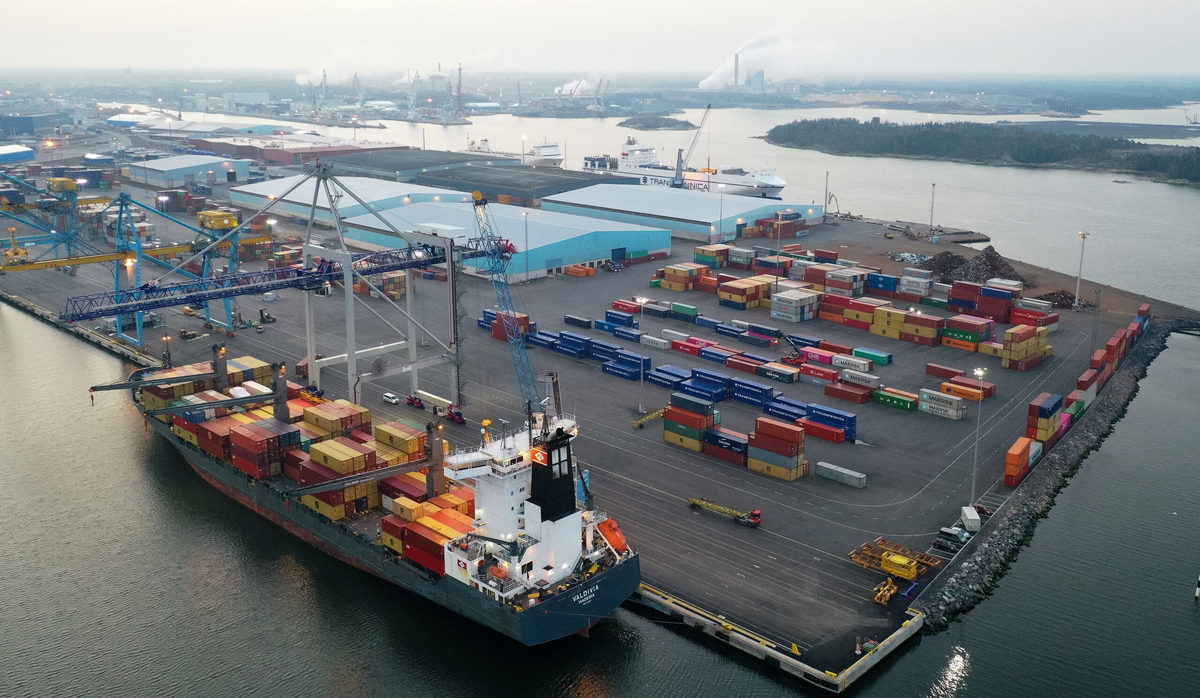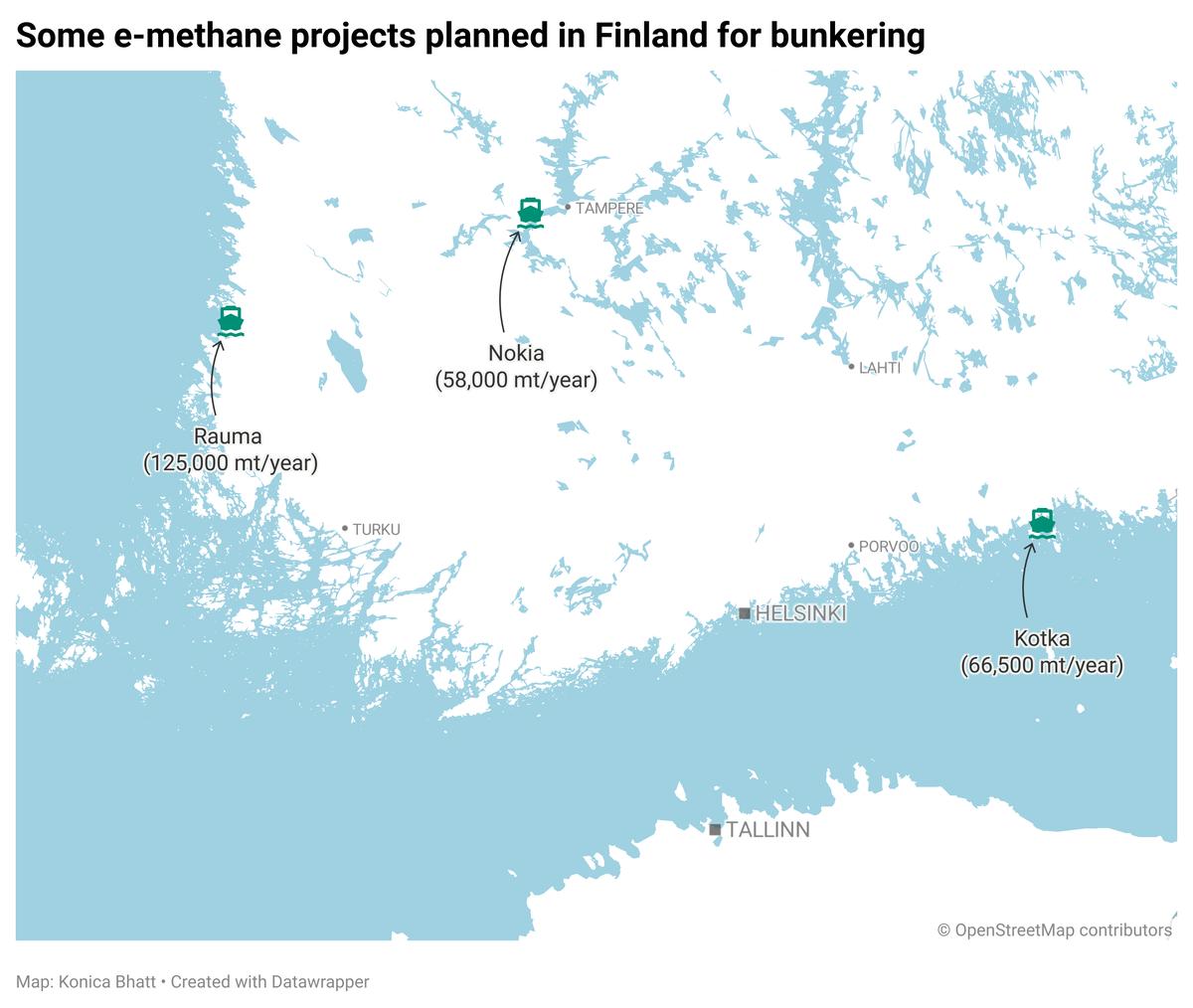The Week in Alt Fuels: The Finnish e-fuel appeal
A growing number of green bunker fuel projects planned in Finland highlight the country’s rising appeal for synthetic fuel production, outshining even the wider Nordic region.
 IMAGE: Aerial view of Port of Rauma in Finland. Port of Rauma
IMAGE: Aerial view of Port of Rauma in Finland. Port of Rauma
Finland's emergence as a future e-fuels hub has been supported by a strong pipeline of e-methane, e-methanol and green ammonia projects targeting maritime demand.
E-methane leads the charge
At least some 20 of the 70 hydrogen and hydrogen derivative projects in Finland are focused on e-methane, Janne Peljo told ENGINE. He is the chief policy advisor of the Confederation of Finnish Industries (CFI).
While not all of these projects will allocate e-fuels for bunkering, at least three have confirmed that they will.
Arctic Sisu Corporation is planning to build a 900–950-gigawatt-hour (63,000–67,000 mt) of e-methane facility in Kotka, targeting a production start-up in 2028. Tree Energy Solutions (TES) and CPC Finland are working on a 125,000 mt/year plant by the Port of Rauma.
Freija Clean Fuel is developing a 58,000 mt/year plant in Nokia by 2029.

Finland is connected to the EU’s natural gas grid through the bi-directional Balticconnector pipeline, which can both send and receive natural gas. E-methane producers can also use this network with mass balancing to distribute synthetic gas across the EU through existing pipelines.
Mass balancing ensures accurate tracking of sustainable feedstocks along the supply chain, blending renewable and non-renewable materials while maintaining an exact record of the sustainable portion.
This simplifies distribution. Producers can feed e-methane into the grid and allocate it to bunker markets elsewhere without physical delivery, making it more efficient and cost-effective.
“Finland has transposed EU RED III into national law and is positioning itself as a pioneer in renewable fuels of non-biological origin (RFNBOs), like e-NG [e-methane],” TES has said. Finland’s “multi-gas energy system” is helping to drive development of large-scale synthetic fuel projects, it argued.
Green grid
“Apart from abundant and competitive renewable electricity in the Nordics, Finland has grids in excellent condition and grid connectivity is much smoother than elsewhere in the Nordics, let alone rest of Europe,” CFI's Peljo said.
National grid operator Fingrid reported a 99.99991% transmission reliability rate in April.
"Unlike some European countries, Finland has constant capacity in the grid for large-scale industrial sites. Much of this is from clean energy,” said Fingrid chief executive Asta Sihvonen-Punkka.
Finland’s renewable electricity infrastructure further enhances its charm. Its national power mix is “among the cleanest” in Europe, according to Business Finland. Wind accounted for over 40% of capacity and hydropower close to 20% in 2025. Nuclear power produced 39% of electricity in 2024, supported by the country's fifth nuclear reactor operating for a full year for the first time.
This combination is well-suited for low- and zero-emission fuel production.
“The outlook for competitive renewable electricity and swift grid connectivity is a major benefit for Finland, increasingly appreciated by foreign investors,” Peljo said.
The incentive engine
Policy support has also bolstered Finland’s appeal.
The government offers a 20% tax credit to companies spending more than €50 million ($58 million) on green industrial projects. The credit is capped at €150 million ($176 million) per company. It supports renewable hydrogen production and hydrogen-based fuels, including marine fuels.
Biogenic CO2 is vital for e-methane and e-methanol production. It's in abundant supply in Finland thanks to its pulp and paper industry and widespread use of bioenergy for district heating, Peljo noted.
These factors seem to be attracting synthetic fuel producers beyond e-methane, as shown by the growing number of planned e-methanol and green ammonia projects.
Liquid Wind has announced two e-methanol plants of 100,000 mt/year capacity each in Naantali and Haapavesi. Green North Energy is advancing green ammonia and hydrogen projects in Naantali, Pori and Kemi.
Potential hurdles for liquid fuels
While e-methane can be allocated across borders via mass balancing and the EU gas grid, e-methanol and green ammonia producers must physically transport their fuels to other ports. This can add to final delivery costs.
As FuelEU Maritime’s e-fuel targets “are set to start driving meaningful demand in the market in 2030s, Finland is attracting new projects aiming for completion by 2030.” Peljo said.
In other news this week, bunker suppliers serving Norway’s domestic shipping sector must ensure that biofuel makes up at least 7% of all sales in 2026 and 8% in 2027, the Norwegian Environment Agency said. While it does not cover international shipping, the mandate includes fuel used for vessels, aquaculture facilities and installations on the Norwegian shelf.
LNG-capable vessels accounted for 11 of 19 alternative fuel-capable vessel orders recorded in DNV’s database. DNV also recorded four orders for methanol-capable vessels, two for hydrogen fuel cell-capable ships and one for LPG. There were no new ammonia-capable vessel orders in June, extending its dry spell into a second month.
Classification society Lloyd’s Register (LR) and German infrastructure firm DAI Infrastruktur plan to develop a green ammonia production and bunkering facility at Egypt’s East Port Said. The facility is expected to begin production by 2029, with a production capacity of up to 2 million mt/year, LR said.
By Konica Bhatt
Please get in touch with comments or additional info to news@engine.online





